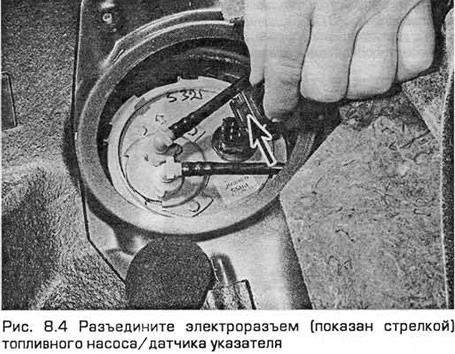Attention! Before you begin, please read the caution in paragraph 1 this chapter.
Fuel pump check
1. Turn on the ignition and listen to the fuel pump (noise when the electric motor is rotating is heard from under the rear seats). Provided there is enough fuel in the tank, the pump should run for one to two seconds and then stop each time the ignition is turned on.
Note: If the pump runs all the time while the ignition is on, then the electronic control device is operating in mode "to drive home" in accordance with Ford's limited operation algorithm. This is almost certainly due to a malfunction of the ECU itself, and therefore the car must be taken to dealers to check the entire system using diagnostic equipment. Do not try to control the system yourself in this case.
2. Listen to the noise from draining fuel from the pressure regulator. You can also feel the fuel pulsing in the regulator and in the delivery hose from the fuel filter. If the pump does not rotate at all, check the fuse, relay and wiring, (chapter 12).
Fuel pressure check
3. This operation requires a fuel pressure gauge with a Schrader valve adapter. This valve is installed on a fitting designed to control / relieve fuel pressure in the line. The valve can be identified by its blue plastic cover. If you have Ford tool 29-033 (see paragraph 2), it can be connected with a valve as well as with a conventional pressure gauge.
4. If you are using a regulated accessory, turn its valve fully counterclockwise and then connect the accessory to the valve. Connect the pressure gauge to the fixture. If you are using a fuel gauge with its own adapter, then connect it following the manufacturer's instructions (see fig. 7.4).

5. Start the engine and bring it to idle. Read the pressure gauge as soon as the pressure is established. Compare the indication with the regulated (see technical data).
- A) If the pressure is too high, check if the drain line is clogged. If it is OK, replace the fuel pressure regulator.
- b) If the pressure is below the regulated one, pinch the fuel drain line. If the pressure then rises, replace the fuel pressure regulator. If the pressure does not increase, check the injection line, fuel pump and fuel filter.
6. Disconnect the vacuum hose from the fuel pressure regulator. The pressure gauge reading should increase. Record the pressure increase and compare it with the one specified in the Specification. If it does not correspond to the regulated, check the vacuum hose and pressure regulator.
7. Connect the regulator vacuum hose and turn off the engine. Make sure the fuel pressure stays at the specified level for five minutes after the engine is turned off.
8. Carefully disconnect the fuel gauge. Before detaching, cover the detachable elements with a cloth. Eliminate fuel leaks.
9. Start the engine and check for leaks.
Visitor comments